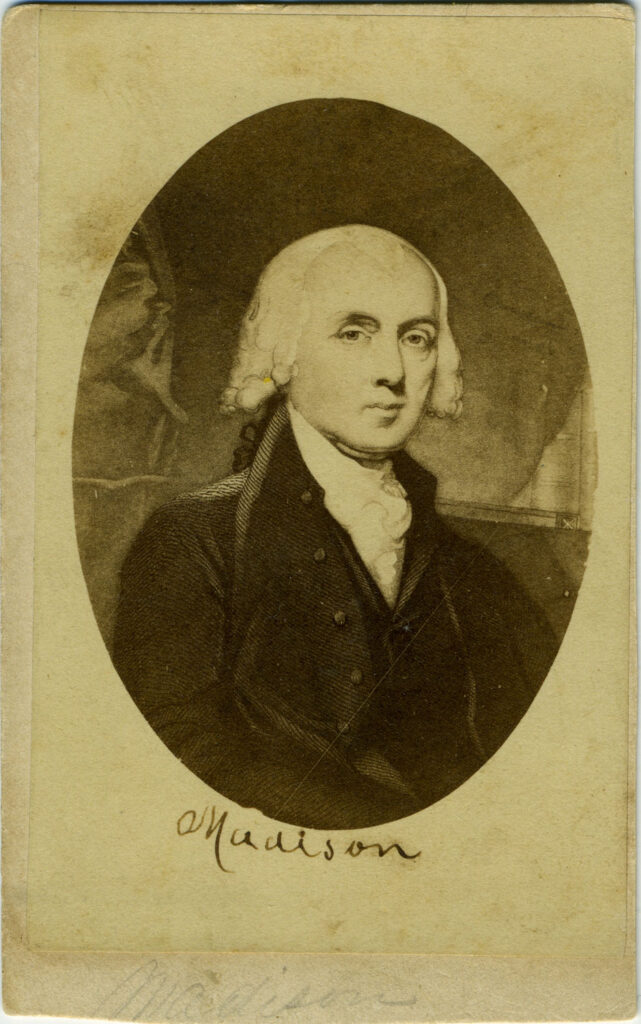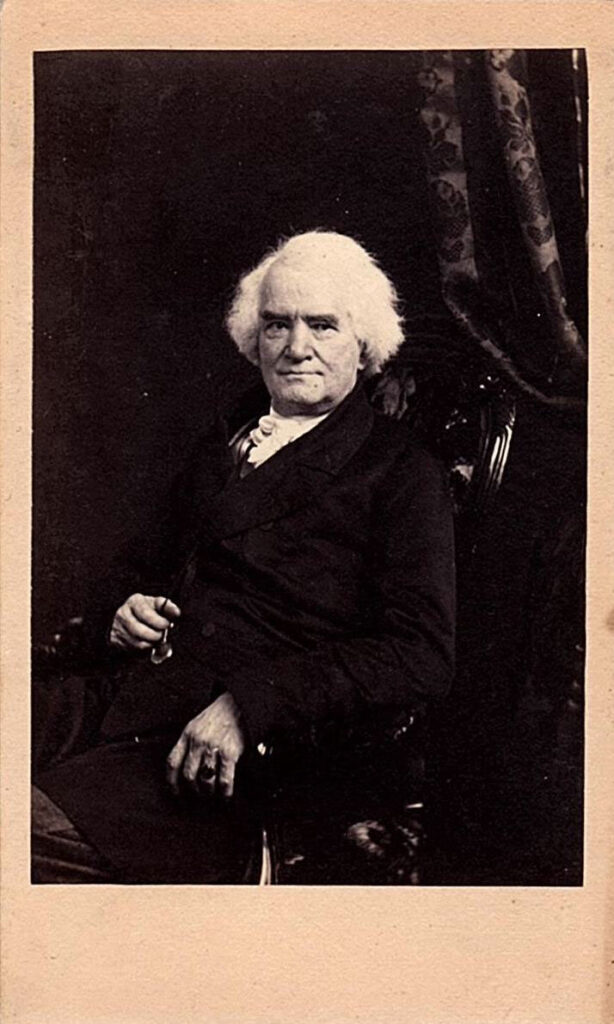Section #4 - Early sectional conflicts over expanding slavery lead to the Missouri Compromise Of 1820
Chapter 36: Madison Concludes Second Term
April 13, 1816

With the War of 1812 over, President Madison adjusts his thinking about two policy matters – namely, his historical opposition to a standing army and to a federal Bank of the United States (BUS).
As a life-long Anti-Federalist, Madison has always regarded a standing army as a weapon by which an aspiring king/dictator can muffle popular political dissent.
However, the nation’s military vulnerability evident in the sack of Washington convinces him of the need to strengthen America’s defense posture.
On March 3, 1815 he calls for “standing army” of 20,000 troops, a move that is still anathema to many Democratic-Republicans. He also sees the impact that the Humphrey class frigates, built from 1794-1800 by the Federalists, have had on battling the British fleet, and supports more upgrades of the navy.
The war also causes Madison to change his mind about the value and role of a Federal Bank pf the United States (or “BUS”).
With Jefferson he has previously viewed a Federal Bank as creating an unelected plutocracy of private financiers who will corrupt the political system by using their “insider knowledge” about upcoming government initiatives to line their own pockets.
A private central bank issuing the public currency is a greater menace to the liberties of the people than a standing army. (Quote attributed to Jefferson.)
For example, in making “loans” to fund “federal projects,” the BUS officers will be tipped off in advance of upcoming projects – say to build a road or canal or railroad or bridge that crosses state lines. The logical result of this early, private knowledge is almost certain to be “speculative actions” by the “insiders.” For example, a rush to buy up land required for the projects at low prices and then sells them back to the government at high prices.
Assuming these projects play out as planned, the BUS officials end up with windfall profits, thus unfairly increasing their private wealth and power.
But the Democratic-Republicans believe that such a bank could threaten the democracy itself.
For example, if the shape of these projects were to change along the way – say a new route is chosen for a road across different land – the BUS’s investment losses could prove staggering not only to the bank owners but also to the general public. It could lead to a spiraling down collapse of the nation’s financial system, as follows:
- The BUS sinks public funds into buying land that is suddenly worth less than what it paid.
- Its cash on hand to pay back principal and interest owed to its depositors begins to run out.
- It tries to replenish its cash by selling the original land, but every sale results in a sizable loss.
- Eventually the cash crisis reaches a point where the BUS is unable to make the payments due.
- News of the shortfalls spread, the public loses confidence in all banks, tries to retrieve deposits.
- Panic runs on all banks break out and bring the entire credit system to a halt.
Fear about this kind of corruption and collapse is why Jefferson had opposed Hamilton’s plans for “multiplying capital” (soft money notes backed by hard gold/silver) and for the Federal Bank.
It is also why, on January 15, 1815, Madison vetoes a bill to charter the Second Bank of the United States.
But as 1815 plays out, Madison experiences first-hand the devastating post-war effects of currency instability and inflation on the economy, and a nation again teetering on the brink of bankruptcy.
His new Secretary of the Treasury, George Dallas, of Pennsylvania, a close friend of Albert Gallatin, convinces him to change his mind about the BUS.
On April 3, 1816, congress to vote in favor of chartering the Second Bank of the United States and Madison signs the bill.
April 27, 1816
“Dallas Tariff”

The new BUS gives the President a way to issue Treasury Bonds, as one source of added revenue. But Dallas tells him that far more revenue is needed to cover debts related to the war.
His solution becomes known as the “Dallas Tariff,” a tax to be levied on select goods imported from abroad.
Over time, the Tariff will become a central issue dividing the South from the rest of the country. But when first proposed, under Madison, it easily passes the House on April 27, 1816 by an 88-59 margin.
While Dallas favors a fairly complex framework – varying the duty tax on whether or not US manufacturers could meet the internal demand for a given good – the final plan is simple:
- A 25% tax on all cotton and woolen imports; and
- A 30% duty on iron, hats, furniture and fine paper.
This tariff would not only add more revenue to the federal government coffers, but also restore good will among New Englanders by “protecting” their emerging manufacturers.
Both Calhoun, and Clay support the tariff, regarding it as a way to lessen regional tensions without much threat to their own local interests. The Southern view is that its economy — fueled by cotton and slave sales – is progressing at the moment, the Democratic-Republicans are firmly in control politically, and the tariff is viewed as a temporary measure anyway.
Madison, however, is not about to bend on one principle – what his Constitution says about the powers vested in the States vs. the federal government.
Thus when Congress allocates funds to build a national road using federal funds from the U.S. Bank, the President’s last act in office is to veto it, based on the Tenth Amendment. Infrastructure projects belong with the States, not in Washington.
March 4, 1817
Madison’s Term Ends And A War-Induced Economic Recession Begins
Madison’s eight years in the White House are now up. They have been consumed largely by the threat and reality of war and with its impact on the economy. As the data on U.S. exports show, he has twice had to resuscitate American trade, first in 1809 after Jefferson’s Embargo Act, and then in 1815, after the end of his own war with Britain. In both instances he has been more successful than not.
Value Of U.S. Exports: Before – After Embargo Act Of 1807 And War of 1812
| 1807 | 1808 | 1809 | 1810 | 1811 | 1812 | 1813 | 1814 | 1815 | 1816 | |
| $ 000 | $108.3 | 22.4 | 52.2 | 66.8 | 61.3 | 38.5 | 28.0 | 6.9 | 52.6 | 81.9 |
| % Ch | (79%) | 133 | 28 | (9) | (37) | (27) | (75) | +++ | 56 |
The nation’s GDP also experiences a string of dislocations. Domestic activity spikes up in 1813 and 1814, in response to fighting the war, then cools off alarmingly in 1814 and 1815, with the peace. It will soon turn into America’s first great depression.
Changes In GDP During Madison’s Terms
| 1809 | 1810 | 1811 | 1812 | 1813 | 1814 | 1815 | 1816 | |
| $ 000 | 687 | 706 | 767 | 786 | 969 | 1,078 | 925 | 819 |
| % Ch | 6% | 3% | 9% | 2% | 23% | 11% | (14%) | (11%) |
| Per Cap | 98 | 98 | 103 | 103 | 123 | 133 | 111 | 96 |
After leaving Washington, Madison will live another 17 years, until his death, at 82 years old, in 1836 – the last of the “founding fathers” to pass.
His tobacco plantation at Montpelier has suffered severe financial losses owing to the trade embargoes, and, as his health declines, he obsessives over defining and defending his role in in the founding of the republic.
But here he needn’t worry. The nation he helped create is now on the brink of achieving the greatness he imagined in 1787 as the acknowledged “Father of the Constitution.”